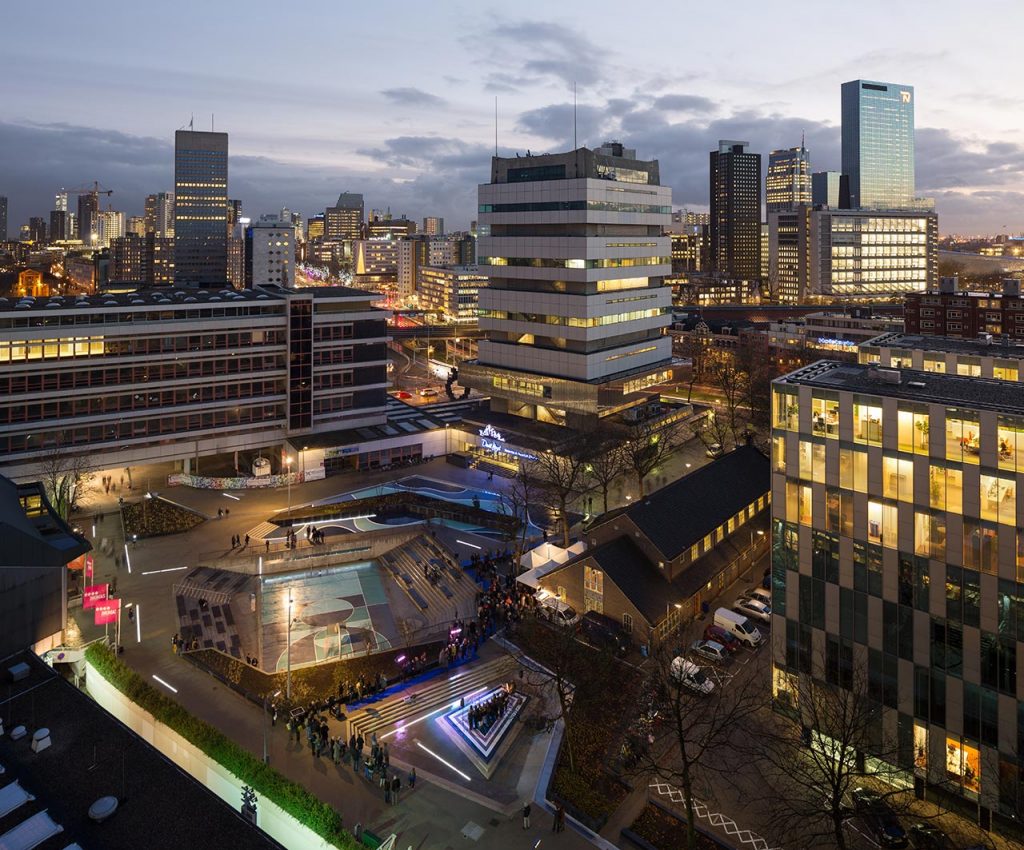The resilience to thrive
Where we live and how we spend our time outside of work play a part in our overall health. Planner Cristian Bevington, who specialises in urban resilience and sustainability, looks to Rotterdam, Netherlands, to show how adapting a public square to cope with flooding is encouraging locals to play, rest and learn.
The importance of designing, building and growing urban resilience to shocks and stresses has never been greater. By 2060, for example, more than one billion people around the world could be living in coastal areas 10 metres below sea level, leaving countless communities, homes and workplaces at serious risk of flooding, especially as sea levels continue to rise and climate change brings heavier and more unpredictable rainfall.

Adaptation and innovation
Surrounded by water, Rotterdam — home to Europe’s largest port — is located in the delta of the Rhine and Meuse rivers. With around 80 per cent of its land below sea level, the city has been investing in innovative water management strategies for centuries, turning its biggest threat into its greatest opportunity.
Today, visitors regularly come to see Rotterdam’s dykes, levees and urban water systems, which include water squares, green roofs, underground water storage and multi-purpose water buffers, creating a vibrant, industrialised port city, with a reputation as a global leader in climate adaptation that aims to be 100 per cent resilient to climate change by 2025.
Withstanding change
Rotterdam was an early member of 100 Resilient Cities (100RC), which helps cities around the world become more resilient to the physical, social, and economic challenges that are a growing part of the 21st century. 100RC is pioneered by The Rockefeller Foundation, which provides funding and support to cope with, and spring back from, chronic stresses like high unemployment, and acute shocks such as floods and earthquakes.
As one of 100RC’s strategy partners, we worked with the City of Rotterdam to develop its first comprehensive resilience strategy, which seeks to build on existing — and promote new — actions and initiatives to enhance city resilience and build healthy and connected people and communities.
A vital sponge
One of the existing projects that the strategy aims to build on, The Benthemplein Water Square, designed by Rotterdam-based design studio De Urbanisten, includes several sunken spaces that can hold 1.7 million litres of rainwater falling directly onto the square and from the roofs of neighbouring buildings. The water then permeates through the pavement to the soil beneath or is pumped to nearby canals, easing the burden on existing sewage systems. It’s so effective at storing storm water that neighbouring buildings have since been disconnected from the municipal drainage system.
Space to play and ponder
With community involvement a key part of the project from the start, members of the local gym, youth theatre, church and schools took part in three workshops to discuss possible uses for the square, agreeing that it should be a dynamic place where people can run, play and relax.
During dry weather, Benthemplein doubles as a vibrant community space, with a basketball court, football pitch, volleyball court and performing arts space, encouraging a more active, engaged and healthier community. Surrounding trees and wild plants create a relaxing setting, where people can sit and ponder. Previously occupied by empty commercial buildings, Benthemplein is now a catalyst for regeneration, with 120 companies now operating in the surrounding Zomerhofkwartier (Zoho) neighbourhood.
Activity and inclusiveness
Developing more resilient infrastructure and public services is crucial in making the places where we live and work sustainable, in cities across the world. Rotterdam shows that resilience strategies bring with them great opportunities to simultaneously tackle risks and create healthy and engaging public spaces for people to enjoy and lead healthier lifestyles, encouraging activity and inclusiveness, while weaving resilience into the fabric of people’s lives.






